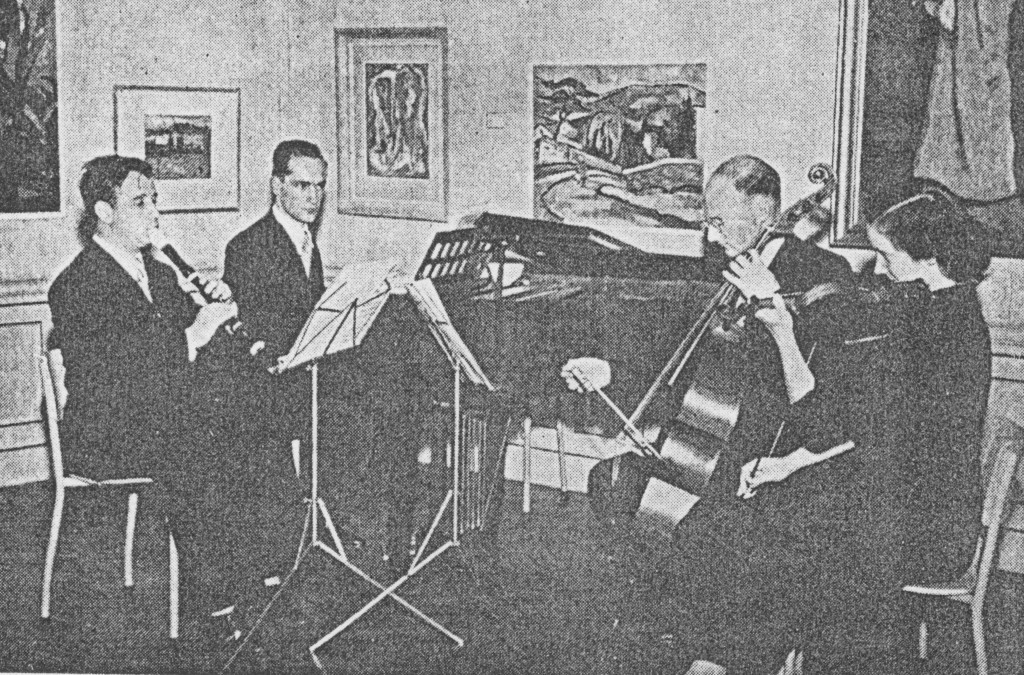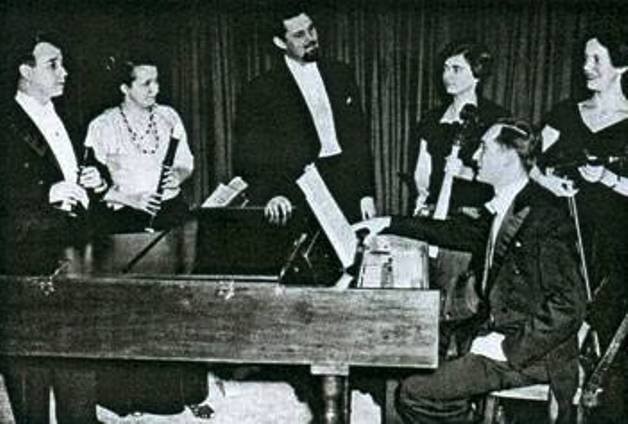
The Leonhardt Consort in 1954. FLTR: Kees Otten, Gustav Leonhardt, Hans Bol and Marie Leonhardt www.semibrevity.com
As one of the two main recorder players in Holland after the war (the other was Joannes Collette) and an acknowledged expert on early music, Kees Otten was well known to George Leonhardt (father of Gustav), who was on the Board of the Dutch Bach Society and himself a well-known figure in the musical scene of Amsterdam.
Otten remembers:
When Leonhardt returned to Holland [from Vienna] his father asked me if I would ‘keep an eye’ on his son [i.e. work with him]. This was a bit of a problem, as I already had a harpsichordist, Jaap Spigt, with whom I regularly performed [since 1950]. But when I started to play with Leonhardt, I found his approach very interesting, and we decided to set up an ensemble together [in 1954] which, because of his impending marriage to Marie, became known as the Leonhardt Consort.
We concentrated on late 17th- and early 18th-century music. Leonhardt wanted to do just Concerts royaux in one concert and then just 17th-century German music in another … which was completely unheard of at that time, and we had many debates about this. My view was that we should end each concert with something by Telemann, which the audience would definitely enjoy! My approach was probably more commercial than his, and I also really liked Telemann.
The players
The initial line-up consisted of Leonhardt who, at that stage, was still playing a pedal-powered harpsichord made by Robert Goble, with a 16-foot stop; his violinist wife, Marie; Kees Otten and the cellist and gamba-player Hans Bol, with whom Leonhardt (and Joannes Collette) had played gamba trios in radio programmes, as part of series devised and introduced by Otten.
Please subscribe to this blog – in the top right corner – and receive notifications of new posts by e-mail.
Otten’s new wife, Marijke Ferguson, was also mentioned as being a member of the new baroque music group, in a newspaper article (about Kees Otten and the recorder) in which the advent of the Consort was announced in May 1954. She told me, however, that she only ever played the second recorder part in John Blow’s Ode on the Death of Henry Purcell, in the concerts given with Alfred Deller; see the photo below.
Bol’s involvement was apparently short lived and Dijck Koster quickly replaced him as cellist. She was a conservatory friend of Marijke Ferguson and Antoinette van den Hombergh (who later joined the Consort, and played the medieval fiddle in Otten’s group, Muziekkring Obrecht). All three of them had previously lived together in a house on the Prinsengracht in Amsterdam, which was reserved for single young ladies.
The violinist Jaap Schröder (who was a member of the Netherlands String Quartet and, at the same time, the concertmaster of the Dutch Radio Philharmonic Orchestra) also occasionally played with the Consort, as well as working with Kees Otten in other formations, particularly for the radio.
The concerts

FLTR: Kees Otten, Marijke Ferguson, Alfred Deller, Dijck Koster, Gustav & Marie Leonhardt (1956) www.semibrevity.com
I’ve been unable to find information about any radio broadcasts made by the first incarnation of the Leonhardt Consort; but I have seen printed programmes from seven concerts which they gave together. It’s difficult to know whether and to what extent they are representative.
They all include a combination of solo sonatas, trio sonatas and harpsichord solos. Between 1954 and 1957, the same pieces regularly appear on programmes given in various small-scale venues, like museums, galleries and castles. Froberger’s Lamentation on the death of Ferdinand III appears four times. The other most popular works come from Frescobaldi, Bach, Johannes Ghro, Samuel Scheidt, Charles Dieupart, Purcell, John Coperario, Domenico Scarlatti, Francesco Turini, Matthias Weckmann, Biber and, surprisingly, given Leonhardt’s aversion to him, Handel. In addition, single works by 14 other composers appear. All the programmes are very varied, with the exception of two concerts given with Alfred Deller, where Purcell and English lute-song composers dominate. In only one instance is there a piece by Telemann, and it does come at the end of the evening.
Leonhardt, speaking of his adventurous repertoire choice in the 1950s, recalls:
Most of it was completely unknown – much of the music we played was what I had brought back from Vienna … We didn’t give many concerts, because the public for such repertoire was still quite small.
About Alfred Deller
Kees Otten was impressed with Deller, whom he met in 1956, but also found him irritating:
Leonhardt also brought us into contact with Alfred Deller, whom he hugely admired … and for us this way of singing was something completely new.
Apart from being very interesting, Deller was also unbelievably lazy. During a rehearsal he only wanted to go through the first few bars of a piece and would then lie down. He would just look at possible difficulties [in the music] and would say, “I don’t know exactly what I’ll do”, and that was certainly the case, as he did something different every time. He more or less improvised half the time, sometimes faster, sometimes slower, just depending on how he felt. We [the Consort] just followed whatever he did.
Leonhardt’s comment is more generous:
I won’t say he was one of the greatest singers, but he was certainly one of the greatest singing artists. That is what makes him unforgettable… It was his diction and ability to convey words that was unsurpassed. His presence was extraordinary and, although the records can be marvellous, they do not really give an idea of what he was like in concert. Working with Deller was certainly one of my most memorable experiences.
(See the blog post on the first recording of Deller, Harnoncourt and Leonhardt here)
During the period when he was involved with Leonhardt, Otten’s more popularising and varied approach led to him giving many more concerts, including around 100 in schools.
If you have any information, concert programs, bootleg recordings or anything else relating to the Leonhardt Consort, or could suggest other people or possible sources, please get in touch by using the Comments Box below. Your reply will not appear on the blog.
However, quite apart from artistic differences, there simply wasn’t much music written for the Consort’s initial combination of harpsichord with one or two recorders and two strings, except for some works by Handel, Telemann and Scheidt. So, the Ottens left the Leonhardt Consort in 1957, and it continued as an ensemble of strings and harpsichord, for which there was, of course, a great deal of repertoire.
In fact, this second, string-band version of the Consort had already started to give concerts in 1956, as Leonhardt had begun the previous year to recruit and train more string players, and provide them with historical instruments and baroque bows.
More on this another time.
Acknowledgments
Thanks are due to Marijke Ferguson, Marina Klunder (Kees Otten’s widow), Jaap Schröder and to Jolande van der Klis for her excellent Oude muziek in Nederland which has been a valuable source in writing this post. The English translations of various quotes are my own.
© Semibrevity 2014 – All rights reserved
Also of interest:
Kees Otten, Dutch recorder pioneer
Muziekkring Obrecht – the first ever Dutch ensemble for medieval & Renaissance music
Frans Brüggen: the early years (1942–1959), with his teacher Kees Otten
Gustav Leonhardt & Martin Skowroneck – Making harpsichord history

Who was the lutenist for the lute songs with Deller that you describe above? Thank you for a fascinating article.
Leonhardt would have played the lute accomp. on the harpsichord.